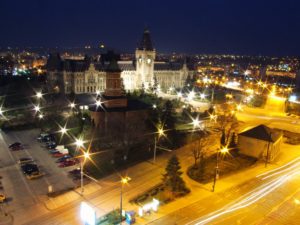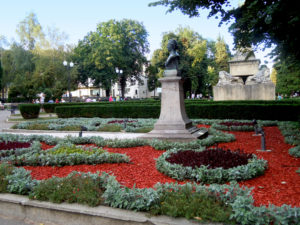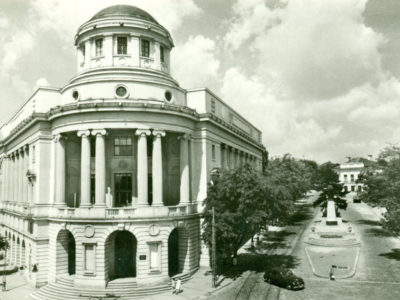Formerly known as Iasi Fair, the city of Iasi is the Iasi county seat and the main urban center in northeastern Romania. Iasi was the capital of Moldova between 1564 and 1859, one of the two capitals of the United Principalities between 1859 and 1862 and also the capital of Romania between 1916 and 1918.
Like ancient Rome, Iaşi is seated on 7 hills: Cetatuia, Galata, Copou, Bucium-Paun, Sorogari, Repedea and Breazu. Iasi is the city of great loves and the first major union, the city where the first theater performance in Romanian was held and also home to the first literary memorial museum (The Hut of Ticau) and to the first Museum of Natural History. Here operates the Alexandru Ioan Cuza University, one of the most prestigious academic institutions in Romania along with four other public universities and seven private ones. Iasi was first mentioned in a commercial privilege issued in 1408 by Moldavian ruler Alexander the Great. However, because there were buildings older than that date (the alleged Armenian church constructed in 1395), it is believed that the city is much older, at least a few decades.
In 1564, the ruler Alexandru Lapusneanu moved the Moldavian capital from Suceava to Iasi.
In 1640 Vasile Lupu established here the first school in Romanian and a printing house within the Three Hierarchs Church. The first book printed in Moldova was issued in Iasi in 1643.
IASI ATTRACTIONS
The Palace of Culture
The Palace of Culture is a landmark building, built between 1906 and 1925, in place of the former Royal Palace. The building served as the Palace of Justice until the year 1955 when it was intended for hosting some of the most important cultural institutions in the city of Iasi, united today under the name of National Museum Complex “Moldova” Iasi that now houses four museums: the History Museum of Moldova, Moldova’s Ethnographic Museum, the Museum of Art, the Museum of Science and Technology “Stefan Procopiu” and Conservation-Restoration Center of Cultural Heritage.
 Eminescu’s Linden Tree & Copou Park
Eminescu’s Linden Tree & Copou Park
Eminescu’s linden tree is a silver linden about 250 years old, found in the Copou Park. This tree, also called “Lovers tree” is where the poet Mihai Eminescu found his inspiration. During his walks through Copou, Mihai Eminescu fell in love with the linden tree, often coming here to gather his thoughts or to talk with his good friend, Ion Creanga on a bench located in the protective shade of the linden. This tree is the oldest one in the Copou Garden. The linden tree trunk, empty from decay had to be filled with mortar and reinforced with muffs (circles) of metal and the branches supported within consoles.
The library in the palm of Mr. Grumazescu Dumitru.
In 200m from the Hotel Traian over on Lapusnenu Street you will find “Dumitru I. Grumazescu’s Antiques Galleries”. Here you can find a collection of Lilliputian books and the smallest book in Europe that can be read only under a microscope.
The Hut of Ion Creanga
Ion Creanga’s hut in Iasi, the first literary memorial museum in Romania (opened on the 15th of April 1918), is one of 12 subsidiaries of the literary Romanian Literature Museum of Iasi. In the house located in the picturesque neighborhood of Ticau, lived between 1872 and 1889 the great storyteller Ion Creanga. The threshold of that house was crossed by Eminescu himself, Creanga’s great friend.
It is noteworthy that the Creanga memorial house is the first memorial house in Romania. The first curator who presented the hut to those who came to visit had the right to live in a small kitchenette to the left of the entrance along with his wife, three children and grandmother.
During his time, Ion Creanga was known for the fact that around his hut from Ticau he had a fairly large group of cats (about 30), and each baring a name associated with a real person in his life. For example, he always had a cat called Marioara, named after his stingy aunt from his native village of Humulesti. Currently there are four cats that prowl the house.
The exhibit showcases objects belonging to the great writer: a silver plated watch, an original lamp, a monogramed silver cigarette case, two icons from the eighteenth century, nineteenth century furniture, a Gheorghe Eminovici original collection of documents, an early nineteenth century “bucoavna”(old book printed in Cyrillic), a Gheorghe Creanga manuscript book, original photographs of Ion Creanga, Constantin Creanga, relatives and friends, a collection of the “Convorbiri Literare’ Magazine, autographed books from the library of Ion Creanga and objects that were part of the collection from the former Ion Creanga Museum at the Golia Monastery in Iasi.
The Botanical Garden
The Botanical Garden is the oldest botanical garden in Romania. It was founded in 1856 by the one who now gives its name, physician and naturalist Anastasie Fatu, on a property bought by him.
The Metropolitan Cathedral
The Metropolitan Cathedral is the cathedral church of Moldova and Bucovina, one of six Orthodox Metropolitan Cathedrals in Romania. The consecration of the Cathedral took place in 1887, King Carol I and Queen Elizabeth taking part in the ceremony. In 1889 it was brought from the Three St. Hierarchs Church, the shrine with the relics of Saint Paraschiva, protector of Moldavia.
Three Hierarchs Monastery
The monastery was built by Prince Vasile Lupu between 1637 and 1639 to serve as the regency necropolis, reflecting the founder’s aspiration to the Byzantine world by combining traditional structures and forms with precious materials and lavish decoration. In the porch are buried Vasile Lupu with his wife and son, Dimitrie Cantermir and Alexandru Ioan Cuza.
The Alexandru Ioan Cuza University
In the building A of the University “Al. I. Cuza ” is located another monument of Iasi, the Lost Steps Hall containing 19 paintings of the painter Sabin Balasa. 9. Union Museum
The building is a historical and architectural monument built between 1800 and 1806 in neoclassical style. The Catargiu house, today harboring the Union Museum was the property of many governing families like the one of the Chancellor Costache Catargiu, General Constantinica Palade and Commander Mihalache Cantacuzino Pascanu.
Between the years 1859 and 1862 the house was the princely residence of the first ruler of the United Principalities – Alexandru Ioan Cuza and between 1916 and 1919 it becomes the residence of King Ferdinand.
Gheorghe Asachi Technical University Library
The library was included in the top 10 most beautiful libraries in the world, occupying the 5th slot.
http://www.infotravelromania.ro/iasi.html
www.wikipedia.com


